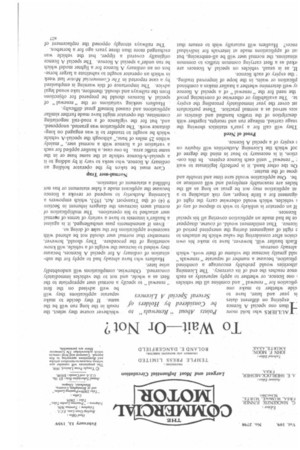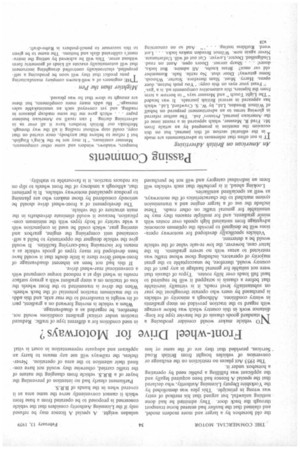To Wait Or Not ?
Page 35

Page 36

If you've noticed an error in this article please click here to report it so we can fix it.
4AULIERS who hold more than one special A licence expiring on different dates is year and later, have to • cide whether to make one iplication for " renewal " and combine all the vehicles one licence, or whether to apply separately as each ence reaches the end of its currency. The Licensing athorities would probably encourage a combined plication, because a number of separate" renewals" ntld greatly increase the volume of their work, which already onerous.
Each haulier will, however, have to make his own cision after considering the value which he attaches to t. right of assignment during the unexpired period of licence. That entitlement would, of course, disappear cc he had made an application covering all his special licences.
If an operator is unlikely to wish to dispose of any of ; vehicles, which would otherwise carry the right of iignment for a little longer, any risk attaching to a nt application may not be great so long as all the hides are reasonably employed and will continue so be. One application would save time and trouble and ;pose of the matter, On the other hand, it is perfectly legitimate to wait 7 " renewal " until each licence expires. In this conction, it is necessary to bear in mind the degree of Dof which the Licensing Authorities will r'equire on .1 expiry of a special A licence.
Proof of Need They will call for a year's statistics showing the triage carried, mileage run and receipts, together with description of the traffics handled and districts or ices served as a normal practice. These particulars 1st cover the year immediately preceding the expiry te. The availability or otherwise of convincing proof the need for the "renewal " of a special A licence ty well determine whether a haulier makes a combined plication or waits, in the hope of improved trading, the expiry of each licence.
If, as is usual, vehicles on special A licences are Irked as a fleet carrying common traffics to common stinations, the normal user will be all-embracing, but at of applications made at intervals for individual ences? Hauliers will naturally wish to ensure that whichever course they select, the result in the long run will be the same. If they decide to make separate applications they will be well advised on the first " renewal" to specify a normal user appropriate to the fleet as a whole, and not to the vehicles immediately concerned. Otherwise, complications will undoubtedly arise later.
Hauliers who have already had to apply for the substitution of ordinary A for special A licences, because they wished to increase the weight of a vehicle, will know something of the procedure. They should, however, remember that normal user should not be altered with successive applications for the sake of doing so.
Even if amendments pass unchallenged, it is against a haulier's interests to have a variety of terms of normal user attached to his operations. The multiplication of normal users increases the dangers inherent in Section 9 (4) of the Transport Act, 1953, which empowers a Licensing Authority to suspend or revoke a licence because the applicant made a false statement or has not fulfilled a statement of intention.
Normal-user Trap Care must be taken by the operator holding an ordinary A licence, who seeks to vary it by adding to it a special-A-licence vehicle at the same base or in the same traffic area. In one case, a haulier applied for such a variation of a licence with a normal user, "mainly within 25 miles of base," although the special-A vehicle which he sought to transfer to it was engaged on longdistance work. The application was granted, unopposed, and, but for the vigilance of a road-rail negotiating committee, the operator might have made further similar applications and caused himself great difficulty.
Hauliers seeking variations or the " renewal " of special A licences should be prepared for objections from the railways and should, therefore, take sound legal advice. The importance of this warning is emphasized by a case reported in The Commercial Motor last week in which an operator sought to substitute a larger horsebox on an ordinary A licence for a lighter model which he ran under a special A licence. The special A licence originally covered a tipper, but the vehicle was exchanged more than three years ago for a horsebox.
The railways strongly opposed the replacement of the old horsebox by a larger and more modern model, and claimed that the haulier had entered horse transport through the back door. They admitted he had done nothing unlawful, but argued that his method of entry was wrong in principle. This plea was demolished by the Yorkshire Deputy Licensing Authority, who declared that the special A licence had been acquired legally and the applicant was fulfilling a public need by operating a horsebox under it.
The 1953 Act places no restriction on the exchange or conversion of vehicles bought from British Road Services, provided that they are of the same or less unladen weight. A special A licence may be refused only if the Licensing Authority considers that the vehicle concerned is proposed to be operated from a base from which it cannot conveniently serve the same area as it covered when in the hands of B.R.S.
Parliament clearly had no intention of preventing the buyer of a B.R.S. vehicle from changing the nature of the traffic carried, otherwise they would not have confined their attention to the area of operation. Nevertheless, the railways will use any means to harry an applicant and adequate representation in court is vital
















































































































